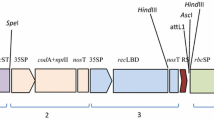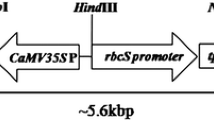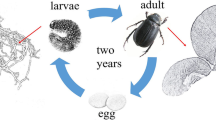Abstract
The lepidopteran Ostrinia furnacalis is one of the most serious pests of maize production. The Cry1C proteins are group of Bacillus thuringiensis (Bt) proteins that are toxic to the intestine of insects. Overexpression of Cry1C protein has led to increased resistance to lepidopteran pests in several crops. In the present study, the synthetic cry1C* gene that was previously tested in rice was introduced into maize Hi-II genotypes via biolistic gun-mediated transformation. A total of nine independent putative callus were obtained and 87 transgenic plants were positive with cry1C* according to polymerase chain reaction (PCR) analysis. Three highly insect-resistant transgenic plants, ZmKc-2-3, ZmKc-3-2, and ZmKc-3-5, were further confirmed by PCR analysis, field assessment, and genomic southern blotting in the T3 generations. Insect bioassays were conducted in both the field and the laboratory, and showed that progeny of the three transgenic lines were significantly resistant to lepidopteran maize pests during the whole development and growth period. The stable integration and expression of the cry1C* in the three transgenic plants’ progeny were confirmed by reverse transcription-PCR (RT-PCR) and enzyme-linked immuno sorbent assay (ELISA) methods. Hybrids were produced by crossing transgenic line ZmKc-2-3 with the elite inbred line Zheng58. There was small variation among the hybrids and backcross offspring, indicating that these cry1C* transgenic lines can be used to produce insect-resistant hybrids and served as insect-resistant sources for the development of Bt maize.





Similar content being viewed by others
Abbreviations
- Bt:
-
Bacillus thuringiensis
- ELISA:
-
Enzyme-linked immunosorbent assay
- RT-PCR:
-
Reverse transcription-PCR
- PCR:
-
Polymerase chain reaction
References
Adang MJ (1985) Characterized full-length and truncated plasmid clones of the crystal protein of Bacillus thuringiensis ssp. kurstaki HD-73 and their toxicity to Manducasexta. Gene 36:289–300
Bates SL, Zhao JZ, Roush RT, Shelton AM (2005) Insect resistance management in GM crops: past, present and future. Nat Biotechnol 23:57–62
Baumgarte S, Tebbe CC (2005) Field studies on the environmental fate of the Cry1Ab Bt-toxin produced by transgenic maize (MON810) and its effect on bacterial communities in the maize rhizosphere. Mol Ecol 14:2539–2551
Cao J, Tang JD, Strizhov N, Shelton AM, Earle ED (1999) Transgenic broccoli with high levels of Bacillus thuringiensis Cry1C protein control diamondback moth larvae resistant to Cry1A or Cry1C. Mol Breed 5:131–141
Cao J, Zhao JZ, Tang J, Shelton A, Earle E (2002) Broccoli plants with pyramided cry1Ac and cry1C Bt genes control diamondback moths resistant to Cry1A and Cry1C proteins. Theor Appl Genet 105:258–264
Carpenter JE (2010) Peer-reviewed surveys indicate positive impact of commercialized GM crops. Nat Biotechnol 28:319–321
Carrillo L, Martinez M, Ramessar K, Cambra I, Castañera P, Ortego F, Díaz I (2011) Expression of a barley cystatin gene in maize enhances resistance against phytophagous mites by altering their cysteine-proteases. Plant Cell Rep 30:101–112
Coll A, Nadal A, Collado R, Capellades G, Messeguer J, Melé E, Palaudelmàs M, Pla M (2009) Gene expression profiles of MON810 and comparable non-GM maize varieties cultured in the field are more similar than are those of conventional lines. Transgenic Res 18:801–808
Daley M, Knauf V, Summerfelt K, Turner J (1998) Co-transformation with one Agrobacterium tumefaciens strain containing two binary plasmids as a method for producing marker-free transgenic plants. Plant Cell Rep 17:489–496
Faria CA, Wäckers FL, Pritchard J, Barrett DA, Turlings TC (2007) High susceptibility of Bt maize to aphids enhances the performance of parasitoids of lepidopteran pests. PLoS One 2:e600
Frutos R, Rang C, Royer M (1999) Managing insect resistance to plants producing Bacillus thuringiensis toxins. Crit Rev Biotechnol 19:227–276
Fujimoto H, Itoh K, Yamamoto M, Kyozuka J, Shimamoto K (1993) Insect resistant rice generated by introduction of a modified δ-endotoxin gene of Bacillus thuringiensis. Nat Biotechnol 11:1151–1155
Greenplate J, Mullins J, Penn S, Dahm A, Reich B, Osborn J, Rahn P, Ruschke L, Shappley Z (2003) Partial characterization of cotton plants expressing two toxin proteins from Bacillus thuringiensis: relative toxin contribution, toxin interaction, and resistance management. J Appl Entomol 127:340–347
Höfte H, Whiteley H (1989) Insecticidal crystal proteins of Bacillus thuringiensis. Microbiol Rev 53:242–255
He K, Wang Z, Zhou D, Wen L, Song Y, Yao Z (2003) Evaluation of transgenic Bt corn for resistance to the Asian corn borer (Lepidoptera: Pyralidae). J Econ Entomol 96:935–940
Ishida Y, Hiei Y, Komari T (2007) Agrobacterium-mediated transformation of maize. Nat Protoc 2:1614–1621
Koziel MG, Beland GL, Bowman C, Carozzi NB, Crenshaw R, Crossland L, Dawson J, Desai N, Hill M, Kadwell S (1993) Field performance of elite transgenic maize plants expressing an insecticidal protein derived from Bacillus thuringiensis. Nat Biotechnol 11:194–200
Li W, Wang D, Jin T, Chang Q, Yin D, Xu S, Liu B, Liu L (2011) The vacuolar Na+/H+ antiporter gene SsNHX1 from the halophyte Salsola soda confers salt tolerance in transgenic alfalfa (Medicago sativa L.). Plant Mol Biol Report 29:278–290
Lin Y, Zhang Q (2005) Optimising the tissue culture conditions for high efficiency transformation of indica rice. Plant Cell Rep 23:540–547
Mendelsohn M, Kough J, Vaituzis Z, Matthews K (2003) Are Bt crops safe? Nat Biotechnol 21:1003–1009
Munkvold GP, Hellmich RL, Rice LG (1999) Comparison of fumonisin concentrations in kernels of transgenic Bt maize hybrids and nontransgenic hybrids. Plant Dis 83:130–138
Nap JP, Keizer P, Jansen R (1993) First-generation transgenic plants and statistics. Plant Mol Biol Report 11:156–164
Perlak FJ, Deaton RW, Armstrong TA, Fuchs RL, Sims SR, Greenplate JT, Fischhoff DA (1990) Insect resistant cotton plants. Nat Biotechnol 8:939–943
Perlak FJ, Stone TB, Muskopf YM, Petersen LJ, Parker GB, McPherson SA, Wyman J, Love S, Reed G, Biever D (1993) Genetically improved potatoes: protection from damage by Colorado potato beetles. Plant Mol Biol 22:313–321
Rhim SL, Cho HJ, Kim BD, Schnetter W, Geider K (1995) Development of insect resistance in tomato plants expressing the δ-endotoxin gene of Bacillus thuringiensis subsp. tenebrionis. Mol Breed 1:229–236
Roush R (1998) Two–toxin strategies for management of insecticidal transgenic crops: can pyramiding succeed where pesticide mixtures have not? Philosophical Transactions of the Royal Society of London. Ser B: Biol Sci 353:1777–1786
Sawahel WA (2002) Production of herbicide-resistant transgenic maize plants using electroporation of seed-derived embryos. Plant Mol Biol Report 20:303–304
Schnepf E, Crickmore N, Van Rie J, Lereclus D, Baum J, Feitelson J, Zeigler D, Dean D (1998) Bacillus thuringiensis and its pesticidal crystal proteins. Microbiol Mol Biol Rev 62:775–806
Sims SR, Stone TB (1991) Genetic basis of tobacco budworm resistance to an engineered Pseudomonas fluorescens expressing the δ-endotoxin of Bacillus thuringiensis kurstaki. J Invertebr Pathol 57:206–210
Stewart CN Jr, Via LE (1993) A rapid CTAB DNA isolation technique useful for RAPD fingerprinting and other PCR applications. Biotechniques 14:748–750
Stewart S, Adamczyk J, Knighten K, Davis F (2001) Impact of Bt cottons expressing one or two insecticidal proteins of Bacillus thuringiensis Berliner on growth and survival of noctuid (Lepidoptera) larvae. J Econ Entomol 94:752–760
Tang W, Chen H, Xu C, Li X, Lin YJ, Zhang Q (2006) Development of insect-resistant transgenic indica rice with a synthetic cry1C* gene. Mol Breed 18:1–10
Torney F, Moeller L, Scarpa A, Wang K (2007) Genetic engineering approaches to improve bioethanol production from maize. Curr Opin Biotechnol 18:193–199
Tu J, Zhang G, Datta K, Xu C, He Y, Zhang Q, Khush GS, Datta SK (2000) Field performance of transgenic elite commercial hybrid rice expressing Bacillus thuringiensis δ-endotoxin. Nat Biotechnol 18:1101–1104
Vaeck M, Reynaerts A, Höfte H, Jansens S, De Beuckeleer M, Dean C, Zabeau M, Montagu MV, Leemans J (1987) Transgenic plants protected from insect attack. Nature 328:33–37
Van Rensburg J (2007) First report of field resistance by the stem borer, Busseola fusca (Fuller) to Bt-transgenic maize. S Afr J Plant Soil 24:147–151
Vasil IK (1994) Molecular improvement of cereals. Plant Mol Biol 25:925–937
Zhao JZ, Cao J, Li Y, Collins HL, Roush RT, Earle ED, Shelton AM (2003) Transgenic plants expressing two Bacillus thuringiensis toxins delay insect resistance evolution. Nat Biotechnol 21:1493–1497
Zhao JZ, Cao J, Collins HL, Bates SL, Roush RT, Earle ED, Shelton AM (2005) Concurrent use of transgenic plants expressing a single and two Bacillus thuringiensis genes speeds insect adaptation to pyramided plants. Proc Natl Acad Sci U S A 102:8426–8430
Acknowledgments
This research was supported by the Genetically Modified Organisms Breeding Major Projects, China (No. 2009ZX08003-016B) and the National High-Technology Research and Development Program of China (Program 863, No. 2012AA101104). The vector plasmid was kindly provided by Dr. Lin Yongjun and Dr. Zhang Qifa from the National Key Laboratory of Crop Genetic Improvement, Huazhong Agricultural University, Wuhan, China.
Author information
Authors and Affiliations
Corresponding author
Rights and permissions
About this article
Cite this article
Du, D., Geng, C., Zhang, X. et al. Transgenic maize lines expressing a cry1C* gene are resistant to insect pests. Plant Mol Biol Rep 32, 549–557 (2014). https://doi.org/10.1007/s11105-013-0663-3
Published:
Issue Date:
DOI: https://doi.org/10.1007/s11105-013-0663-3




